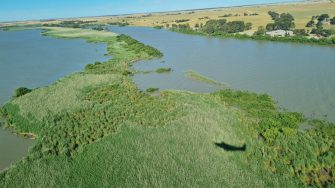
Date: Monday, November 8, 2021
Project: Eastern Australian Waterbird Survey
Observers: Richard Kingsford & John Porter
Pilot: James Barkell
The last two weeks had been difficult as we have waited to find out whether or not we would be classified as essential workers and able to finish off are survey in South Australia and Queensland. Thankfully the news was good for South Australia, amber for Queensland (fingers crossed). It was time to get back in the air.
This week we headed down to the River Murray, the Lower Lakes and the Coorong – a three day trip. Luckily, we soon escaped the inclement Sydney weather, heading straight for Mildura, unfortunately into a 30km headwind which slowed us down. The hours add up by the end of the day.
Along the way we flew over Wyangala Dam on the Lachlan River, the cause of considerable environmental concern in relation to its proposed doubling in size, capturing the essential floods in the river.
After a quick stop to refuel, we were into surveying again, along the River Murray, west of the NSW town of Wentworth.
Here, the Darling River, with its much smaller channel comes in from the north to pour its brown water full of sediment into the River Murray, before the two rivers start heading west, over Lock 10, and on towards the Southern Ocean. The River Murray from here on, near Wentworth, is divided into a series of locks, put in for the navigation of wool barges and other produce from the other trading states.
There are always very few waterbirds on the main part of the Murray but today there were even fewer than usual. Even the billabongs beside the River Murray which usually have a few more waterbirds had hardly any waterbirds.
It wasn't until we got to the Chowilla floodplain and its wetlands that we really started to see the effects of water on the land, wetlands and biodiversity. Here environmental water had made its way into a series of lakes like Lakes Littra and Woolpool and Gum Flat and the system was pulsing.
There were hundreds of waterbirds, including black swans, grey teal, Australian shelduck, red-necked avocets and small colonies of white ibis and straw-necked ibis.
Along the main channel of the river, the houseboats often outnumbered the waterbirds
Once we had finished surveying the Riverland up to Banrock Station near Berri, we headed south and picked up the River Murray where it’s confined to the main channel by cliffs on either side.
Most of the lower River Murray is confined to the main channel by cliffs on either side.
We surveyed a small section of the river down here of a few kilometres, with more than 50 waterbirds, including cormorants, pelicans and swans. And then it was on to survey the Lower Lakes.
First on our list was Lake Alexandria. The two lower lakes are massive and it takes us nearly three hours to fly their perimeters, as we trace every bay and shoreline.
Extensive shorelines of Lake Alexandrina
It had already been a long flight from Sydney as we flew the northern boundary all the way into Goolwa.
he lake was the fullest we had seen it for some time, with reedbeds flourishing everywhere around its edges. There were reasonable numbers of great cormorants, pelicans, whiskered terns and lots of black swans with many broods. Still – nothing like the numbers we had surveyed in the past. Perhaps not a great surprise, given how much water there was around but we were hoping for more birds.
There were some impressive straw-necked colonies in some of the reedbeds.
Surveying one of the colonies of a few thousand straw-necked and white ibis breeding on Lake Alexandrina
We got to Goolwa and refueled. And then it was back into the plane to do another two hours to finish off our first count on Lake Albert and Lake Alexandria. It had clearly been a good season around here.
Shoreline of Lake Alexandrina abutting the hay fields bordering the lake.
On our way around the southern shoreline of Lake Alexandrina, we surveyed the pied cormorant colony which is a constant at this time of year, numbering in the thousands. It was impressive.
Pied cormorant colony.
There were also a few straw-necked ibis nesting on the edge of the pied cormorant colony and a small colony of royal spoonbills nesting near the mouth of this bay of Lake Alexandrina, with the colony of pied cormorants.
The only duck in reasonable numbers on the two lakes was the Australian shelduck, with probably no more than 100 black duck and grey teal.
We ended up finishing Lake Alexandrina where we had started it, where the River Murray flows in from the north.
It had been a very long day of survey, nearly nine hours by the time we were done. But we had got a lot done. Tomorrow we would be surveying the Coorong and our second count on the lower lakes.
